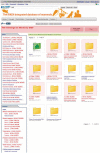The RIKEN integrated database of mammals
- PMID: 21076152
- PMCID: PMC3013680
- DOI: 10.1093/nar/gkq1078
The RIKEN integrated database of mammals
Abstract
The RIKEN integrated database of mammals (http://scinets.org/db/mammal) is the official undertaking to integrate its mammalian databases produced from multiple large-scale programs that have been promoted by the institute. The database integrates not only RIKEN's original databases, such as FANTOM, the ENU mutagenesis program, the RIKEN Cerebellar Development Transcriptome Database and the Bioresource Database, but also imported data from public databases, such as Ensembl, MGI and biomedical ontologies. Our integrated database has been implemented on the infrastructure of publication medium for databases, termed SciNetS/SciNeS, or the Scientists' Networking System, where the data and metadata are structured as a semantic web and are downloadable in various standardized formats. The top-level ontology-based implementation of mammal-related data directly integrates the representative knowledge and individual data records in existing databases to ensure advanced cross-database searches and reduced unevenness of the data management operations. Through the development of this database, we propose a novel methodology for the development of standardized comprehensive management of heterogeneous data sets in multiple databases to improve the sustainability, accessibility, utility and publicity of the data of biomedical information.
Figures




References
-
- Abbott A. Plant genetics database at risk as funds run dry. Nature. 2009;462:258–259. - PubMed
-
- Maltais LJ, Blake JA, Eppig JT, Davisson MT. Rules and guidelines for mouse gene nomenclature: a condensed version. International Committee on Standardized Genetic Nomenclature for Mice. Genomics. 1997;45:471–476. - PubMed
Publication types
MeSH terms
LinkOut - more resources
Full Text Sources
Miscellaneous

